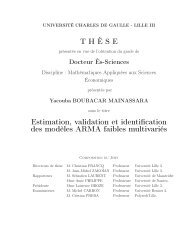A particle-in-Burgers model: theory and numerics - Laboratoire de ...
A particle-in-Burgers model: theory and numerics - Laboratoire de ...
A particle-in-Burgers model: theory and numerics - Laboratoire de ...
You also want an ePaper? Increase the reach of your titles
YUMPU automatically turns print PDFs into web optimized ePapers that Google loves.
Mo<strong>de</strong>l <strong>and</strong> motivation Auxiliary steps Results h = 0: coupl<strong>in</strong>g h = 0: <strong>de</strong>f<strong>in</strong>ition, uniqueness h = 0: <strong>numerics</strong>, existence The coupled problem<br />
Frozen <strong>particle</strong>: a f<strong>in</strong>ite volume scheme...<br />
We use a well-balanced f<strong>in</strong>ite volume scheme , preserv<strong>in</strong>g exactly<br />
(some of) the stationary sols u(t, x) := u−1l {x0}.<br />
Usual schemes are <strong>de</strong>term<strong>in</strong>ed by a numerical flux g(·,·) :<br />
– g locally Lipschitz;<br />
– g(u, u) = u2<br />
2 (consistency );<br />
– g(·, b) is ր, g(a,·) is ց (monotonicity ).<br />
We only modify g(·,·) at the <strong>in</strong>terface x = 0 (between x0 <strong>and</strong> x1):<br />
g −<br />
λ<br />
(a, b) = g(a, b + λ) <strong>and</strong> g+<br />
λ (a, b) = g( a − λ,b).<br />
I<strong>de</strong>a : g ±<br />
λ “only see” the G 1 λ part of the germ !<br />
Then the scheme writes<br />
∀i = 0, 1 u n+1<br />
i = u n i<br />
i = 0 : u n+1<br />
0 = un 0<br />
i = 1 : u n+1<br />
1<br />
Numerical solution:<br />
u∆(t, x) = <br />
n∈N<br />
− ∆t<br />
∆x (g(un i , un i+1 )−g(un i−1 , un i ));<br />
∆t − ∆x (g− λ (un 0 , un 1 )−g(un −1 , un 0 ));<br />
= un 1 − ∆t<br />
∆x (g(un 1, u n 2)−g +<br />
λ (un 0, u n 1)).<br />
<br />
i∈Z un i 1l (n∆t,(n+1)∆t)(t) 1l (xi−1/2,x i+1/2)(x).
















